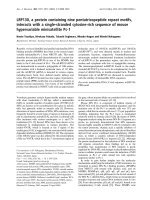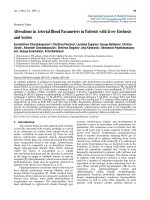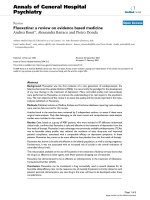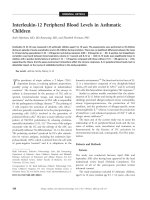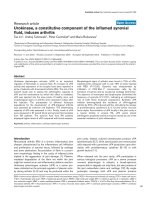Báo cáo y học: "Can a simple blood test quantify brain injury" ppsx
Bạn đang xem bản rút gọn của tài liệu. Xem và tải ngay bản đầy đủ của tài liệu tại đây (39.59 KB, 2 trang )
Available online />Page 1 of 2
(page number not for citation purposes)
Abstract
Despite significant advances in neurocritical care, it remains difficult
to precisely measure the extent of neurological injury in patients
affected by stroke, trauma, or cardiac arrest. In the intensive care
unit the extent of primary and secondary injury often eludes
clinicians, making prognostication imprecise and difficult. Derwall
and colleagues present their findings on the dynamics of serum
S-100B protein levels in out-of-hospital cardiac arrest survivors.
Their study suggests that elevation of S-100B reflects the severity
of the primary hypoxic-ischemic insult.
The first decade of the 21st century has witnessed explosive
growth in therapies for the critically ill neurological patient.
Some of these treatments, such as the use of recombinant
tissue plasminogen activator for the treatment of acute
cerebral infarction, target very specific pathogenic pathways.
Others, such as hypothermia for the treatment of brain injury
after cardiac arrest, have multiple additive and synergistic
mechanisms of action that culminate in the protection of
nervous tissue. To guide these treatments, technological
advances in imaging and neuromonitoring can now provide a
window into the metabolic and physiologic status of the
injured brain, allowing us to evaluate the effect of our
therapeutic interventions in real time.
Despite these promising advances, it remains difficult to
precisely measure the extent of neurological injury in patients
affected by stroke, trauma, or cardiac arrest. In the intensive
care unit, where neurological deterioration is often obscured
by encephalopathy or sedative medications, determination of
the extent of primary and secondary injury often eludes
clinicians, making prognostication imprecise and difficult.
For decades, researchers have sought clinically useful bio-
markers of nervous system injury, and these efforts have
intensified in the past few years. Early candidates for brain
injury biomarkers included lactate dehydrogenase and
creatinine kinase enzyme subtypes in the serum and
cerebrospinal fluid. These proved to be of little use given their
lack of specificity for nervous tissue injury. The ideal bio-
marker would be highly sensitive and specific for neurological
injury, rapidly available from the serum or other easily
obtained body fluid other than cerebrospinal fluid, and
released in proportion to the severity of the injury, with little
variability across different diagnostic and demographic
groups.
Although the ideal biomarker remains elusive, several different
molecules have shown promise. Of these, neuron specific
enolase, myelin basic protein, glial fibrillary acidic protein, and
the S-100B protein have received the most attention.
In a recent issue of Critical Care, Derwall and colleagues [1]
present their findings on the dynamics of serum S-100B
protein levels in a prospectively studied cohort of out-of-
hospital cardiac arrest (OHCA) survivors. S-100B is a
constitutive protein of glial cells. Due to specificity of its
cellular expression, it is considered a potentially useful marker
of acute injury to the brain parenchyma and blood-brain
barrier.
Sixty-eight OHCA patients were enrolled over the course of
two years in five different hospitals in the city of Aachen,
Germany. Sampling of serum S-100B was performed 6, 12,
24, 72 and 120 hours after the return of spontaneous circu-
lation. About half of these patients were treated with thera-
peutic hypothermia and half with standard supportive care,
according to the preferences of the family and treating
physician. Cooling was induced to maintain core temperature
at 33°C for 24 hours using refrigerated saline and body
surface cooling with ice water bags.
The results of this study reflect the difficulties that typically
hamper the interpretation of small non-randomized studies.
No differences were detected in S-100B levels between the
Commentary
Can a simple blood test quantify brain injury?
Stephan A Mayer and Guillermo Linares
Neurological Intensive Care Unit, Milstein Hospital Building, 177 Fort Washington Avenue, Suite 8-300 Center, New York, NY 10032, USA
Corresponding author: Stephan A Mayer,
Published: 15 July 2009 Critical Care 2009, 13:166 (doi:10.1186/cc7929)
This article is online at />© 2009 BioMed Central Ltd
See related research by Derwall et al., />OHCA = out-of-hospital cardiac arrest.
Critical Care Vol 13 No 4 Mayer and Linares
Page 2 of 2
(page number not for citation purposes)
hypothermic and normothermic patients. It is our view that
this should not be interpreted as lack of efficacy of
hypothermia, an intervention that has been shown to improve
survival and recovery after OHCA in large randomized control
trials [2-5]. The lack of randomized treatment allocation
makes it hard to reach any definitive conclusions regarding
the effect of therapeutic hypothermia. It also remains possible
that S-100B is not a useful surrogate marker for the efficacy
of delayed therapeutic interventions such as hypothermia for
OHCA. This may reflect the fact that most of the damage
measured by S-100B elevation is related to the primary
global hypoxic-ischemic insult, rather than temperature-
modifiable reperfusion injury.
By contrast, this paper does suggest that S-100B may have
utility as a prognostic indicator after OHCA. S-100B levels
were significantly lower in patients with a favorable outcome,
but only among those treated with hypothermia. It may be that
the uniformly poor outcomes among those treated with
normothermic supportive care reduced the ability of S-100B
to discriminate between poor and favorable outcomes.
From a clinical perspective, however, the most important
finding of this study is that S-100B levels were consistently
the highest on admission, with a progressive decline over the
next several days. These findings suggest that elevation of S-
100B reflects the severity of the primary hypoxic-ischemic
insult, rather than the effects of the cooling intervention.
Neuron specific enolase has been recognized in recent
guidelines developed by the American Academy of Neurology
as a useful prognostic indicator in comatose patients with
global hypoxic-ischemic brain injury [6]. Derwall and
colleagues now present data suggesting that admission
S-100B levels may also be useful in this setting. The obvious
challenges now are to determine whether panels of multiple
biomarkers provide greater prognostic accuracy than any
single measure, and to better understand how hypothermia
influences the relationship between S-100B elevation, the
severity of the initial insult, and long-term outcome.
Competing interests
The authors declare that they have no competing interests.
References
1. Derwall M, Stoppe C, Brücken D, Rossaint R, Fries M: Changes
in S-100 protein serum levels in survivors of out-of-hospital
cardiac arrest treated with mild therapeutic hypothermia: a
prospective, observational study. Crit Care 2009, 13:R58.
2. Bernard SA, Gray TW, Buist MD, Jones BM, Silvester W, Gut-
teridge G, Smith K: Treatment of comatose survivors of out-of-
hospital cardiac arrest with induced hypothermia. N Engl J
Med 2002, 346:557-563.
3. Bernard SA, Buist M: Induced hypothermia in critical care
medicine: A review. Crit Care Med 2003, 31:2041-2051.
4. Holzer M, Bernard SA, Hachimi-Idrissi S, Roine R: Hypothermia
for neuroprotection after cardiac arrest: Systematic review
and individual patient data meta-analysis. Crit Care Med 2005,
33:414-418.
5. Bernard S: Therapeutic hypothermia after cardiac arrest.
Neurol Clin 2006, 24:61-71.
6. Wijdicks EFM, Hijdra A, Young GB, Bassetti CL, Wiebe S: Prac-
tice Parameter: Prediction of outcome in comatose survivors
after cardiopulmonary resuscitation. Neurology 2006, 67:203-
210.




